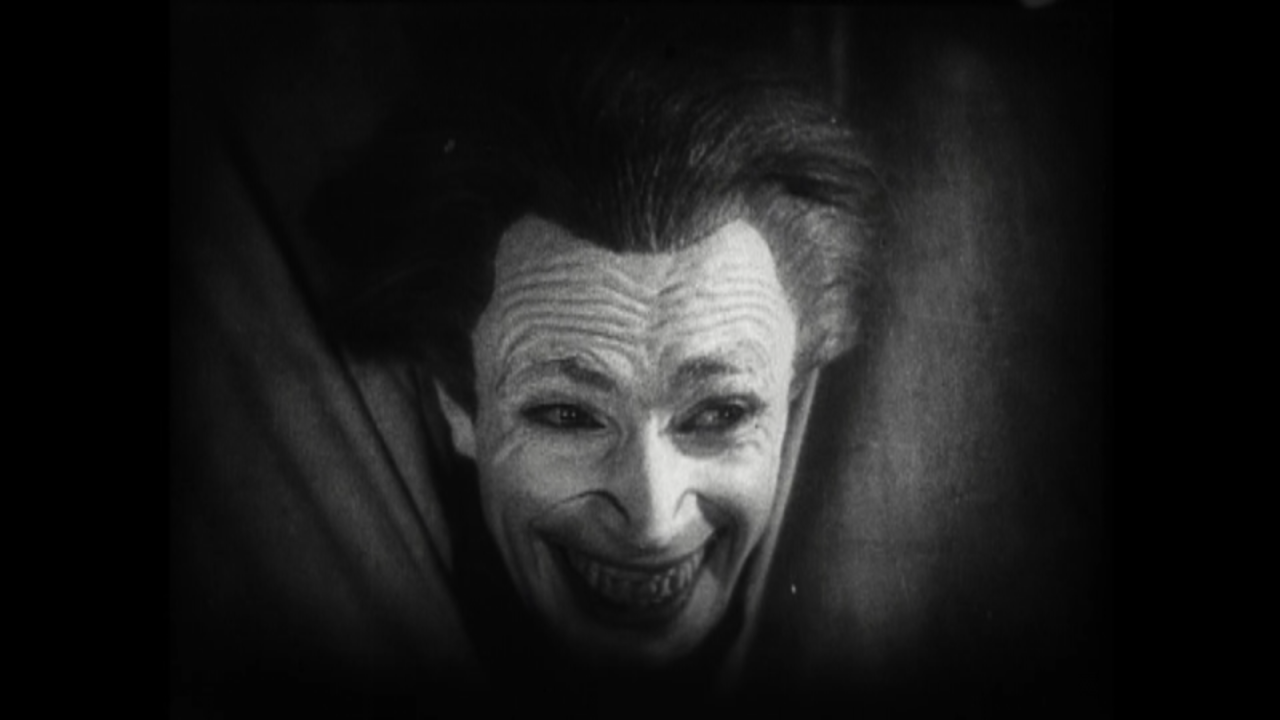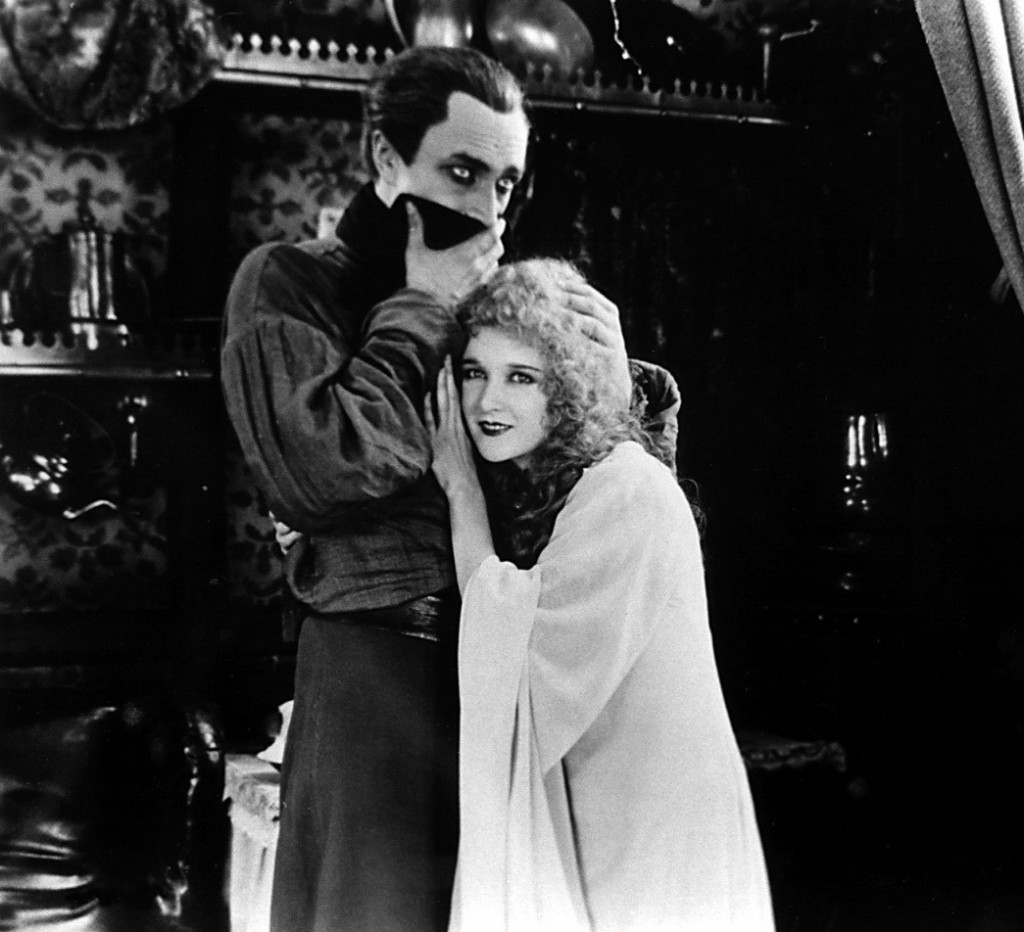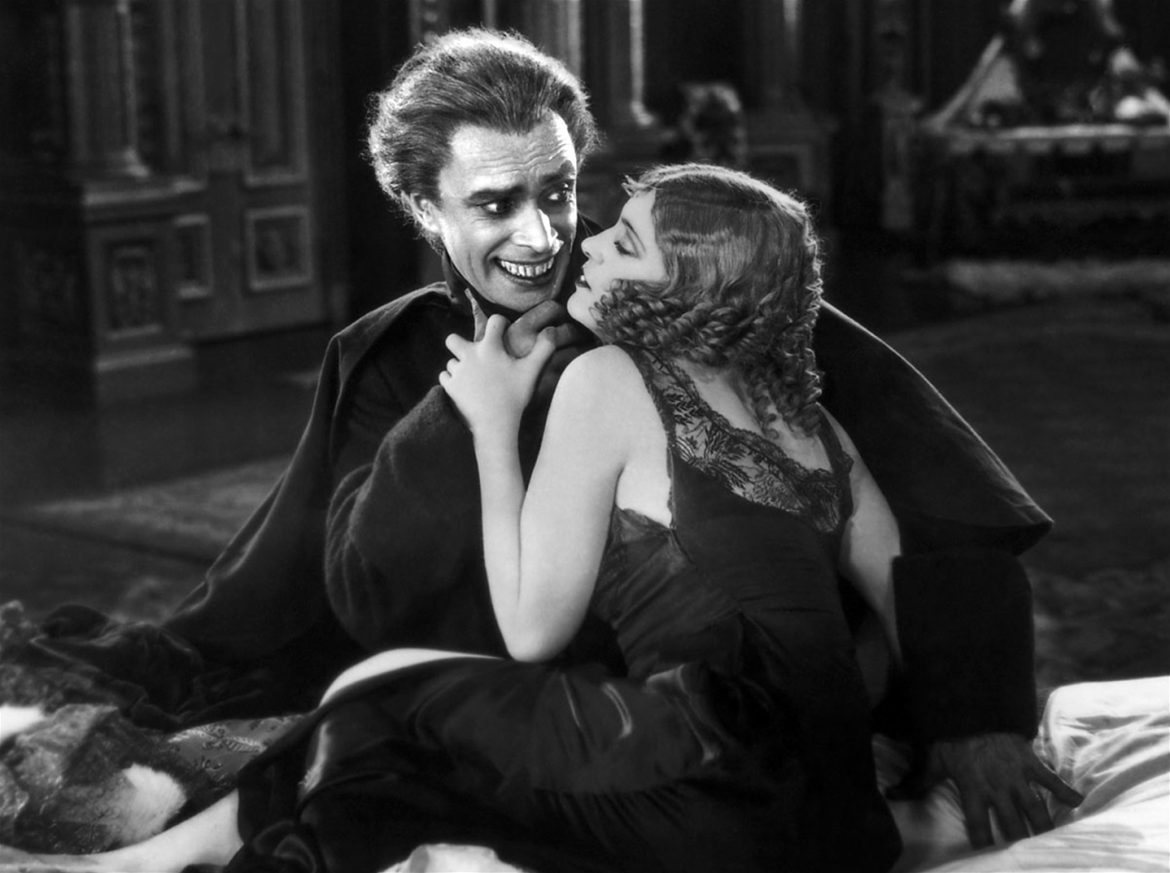The stories of Victor Hugo provided a wealth of material throughout the Silent Era, a source of inspiration that cinema would return to again and again. By the time Universal coaxed German Expressionist master Paul Leni to Hollywood to helm The Man Who Laughs in 1928, a full 53 separate treatments of Hugo had already been released in the previous 23 years. That’s a startling commitment, across media, to an authorial vision.
The monstrous, the tragic, and the doomed featured prominently — The Man Who Laughs joins The Hunchback of Notre Dame, as well as Gaston Leroux’s The Phantom of the Opera, as primary examples of this fixation. Perhaps this was because the new cinematic technologies allowed directors, editors, set designers, and makeup artists to emphasize the uncanny qualities of the image, and nothing is more uncanny than disfigurement and bodily mystery. (In both Phantom and The Man Who Laughs, faces are often obscured, heightening tension and suggestion.) Or perhaps audiences simply thrilled to see familiar Gothic tales rendered through horror photography and the moving image, with all their attendant shadow-play and haunting close-ups.
The Man Who Laughs, however, is not quite horror, though Leni fills the frame with so much ominous atmosphere — all crooked sightlines and macabre insinuation — that it sometimes seems to be. Unlike his previous Waxworks and The Cat and the Canary, and The Last Warning (released the following year, just before his untimely death), the horror is incidental to the story here.
The other films all skillfully combine frightening set-pieces with wacky hijinks, setting the stage for many a horror-comedy to follow. But The Man Who Laughs has no such assurance: it’s a brooding horror one moment, a tragic romance the next, a satire of court politics, and eventually a swashbuckling adventure. This creates a strange tension, and the sense that Leni isn’t quite sure what the film is supposed to be.
 In any case, The Man Who Laughs starts horrifyingly enough. The young Gwynplaine (Conrad Veidt, the somnambulist of Caligari and, much later, the unforgettable Major Strasser of Casablanca) is son to a Scottish nobleman (also Veidt) who defies the king. He must watch his father put to death in an iron maiden. Then, doubling down on the nastiness, the king orders that Gwynplaine have a permanent smile carved into his face, so he will forever laugh at his father’s folly.
In any case, The Man Who Laughs starts horrifyingly enough. The young Gwynplaine (Conrad Veidt, the somnambulist of Caligari and, much later, the unforgettable Major Strasser of Casablanca) is son to a Scottish nobleman (also Veidt) who defies the king. He must watch his father put to death in an iron maiden. Then, doubling down on the nastiness, the king orders that Gwynplaine have a permanent smile carved into his face, so he will forever laugh at his father’s folly.
That’s … pretty horrific.
We pick up years later, as Gwynplaine first rescues a baby in the snow, and then finds comfort, shelter, and employment for the two of them with a traveling band of montebanks. His disfigured face is the centerpiece of the traveling troupe’s performances, sending audiences into fits of laughter and glee at his expense. He’s a star, but at significant cost to his dignity and well being. Thus, we have a truly pathetic protagonist: the saddest clown ever.
The baby Gwynplaine rescued grows up to be the blind Dea (Mary Philbin, who we recently met as Christine in Rubert Julian’s much more cohesive adaptation of Phantom); the two — one a disfigured beast-clown who can’t bear to be looked at, the other a beautiful Belle who couldn’t see him if she tried — fall in love, of course.

Meanwhile, it comes to the attention of Queen Anne that Gwynplaine is a nobleman, despite his off-putting visage, and she decrees that he should marry the vain and tempestuous Duchess Josiana (Olga Baclanova, the Madonna-lookalike villainess of Todd Browning’s Freaks, another film obsessed with tragic deformity and the cruelty of “polite” society). So begins an entirely different kind of film, focused on the mockery Gwynplaine faces from the well-cultured monsters of the House of Peers and Josiana’s simultaneous attraction to and revulsion from his appearance. A reckoning is coming, as the film(s) try to balance all this broad melodrama with the more personal stories buried inside.

It doesn’t quite work. But what certainly does work is Veidt’s commitment. Throughout all these machinations, it’s impossible to look away from his Gwynplaine. Veidt’s performance is essentially divided between the two halves of his face: eyes that convey love, sorrow, fear, and rage above, and that unchanging rictus grin below. It’s hard to imagine pulling it off in the sound era — indeed, Kirk Douglas considered doing so, before thinking better of it. After The Man Who Laughs, Veidt feared type-casting solely in monstrous roles and swore off them; this is a good one to go out on.
At nearly two hours, The Man Who Laughs is over-packed with narrative. Leni makes good use, as you’d expect, of light and dark, constructing a 17th century England for Hollywood that looks more like a German Expressionist fever dream of nowhere in particular. An evocative scene recalls Murnau’s Nosferatu; elsewhere, the attacks on royal pedigree, arrogance, and dissolution — often conveyed through dress and manner — call to mind any number of works disgusted with the ruling class. The Man Who Laughs is firmly on the side of the dispossessed and star-crossed lovers.
For all of that, Leni’s film is still a frustratingly scatter-shot affair, throwing everything at the screen and hoping it gels. It doesn’t really, and there’s a lingering sense that we are watching the last gasps of Expressionist silent cinema, the final moments of Hollywood’s enthusiasm for the Germanic baroque.
Still, Veidt delivers a master performance that would live on in the imagination. Indeed, a number of years later, his pathetic image would be reborn, infused with significantly more malice, and made memorable for generations in the comic book figure of The Joker. It’s hard to imagine that’s what Hugo, Leni, or Veidt would’ve particularly wanted for Gwynplaine, but influence works in strange ways.
The film is more disturbing than it might have been because of Leni’s mastery of visual style. In The Haunted Screen, her history of the German silent period, Lotte Eisner notes that the Expressionists often used unusually low ceilings and doorways in order to force their characters to walk stooped over or sideways. Their staircases rarely climbed frankly from floor to floor, but seemed to twist away into mystery. Dramatic lighting left much of the screen in darkness. Concealment and enhancement, not revelation, was the assignment of the camera. Eisner quotes Leni on the visual style of his “Waxworks,” made four years before “The Man Who Laughs”: “All it seeks to engender is an indescribable fluidity of light, moving shapes, shadows, lines, and curves. It is not extreme reality that the camera perceives, but the reality of the inner event…”

